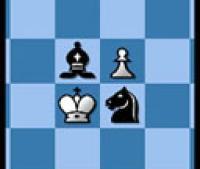Book Review: Winning Chess Endings
Raise your hand if you hate playing the endgame. That’s what I thought; I’m not alone. OK, well, “hate” might be a bit strong, but maybe “dread” is a better term.
Nothing about chess is easy, but it’s not too hard to find direction in both the opening and the middlegame. Even if at first you don’t memorize any openings, you can do alright by just focusing on some basic principles, i.e. control the center, develop your pieces and so on. In the middlegame you need to figure out your own strategy, but there are guiding principles for those, too. For instance, how too create a decent pawn structure, upon which part of the board you should focus your attack, and the like.
What about the endgame? There’s this sort of vague notion that you have to put your opponent’s King in checkmate while you avoid having your own King similarly beaten-up. That, quite frankly, aint a whole lotta help.
In his book, Winning Chess Endings, Yasser Seirawan does give strategies for playing the endgame, but they are strategies for each specific type of endgame. Don’t get me wrong. There are plenty of tactics in this book that should be memorized, and as Seirawan tells us, being a good endgame player requires being a good tactician. The ending lessons start with the basic (one or two pieces and a King against a lonely old King) and then progresses into more complicated endings (multiple pieces and a King against a King and a few of his buddies).
Seirawan also points out that an important part of learning these endings is to first learn the given example and then alter the example slightly to see how that affects the outcome of the ending. You might be surprised at how different two endings can be by just altering the starting position of a single pawn.
Having said all that, Winning Chess Endings does give guiding principles for dealing with certain endings, so it’s usually not a memorization-or-nothing kind of thing.
Having introduced the reader to these endings, Seirawan mixes in quizzes to reinforce the topics. Those who have read my previous book reviews may remember my complaints that two of the previous books in the Winning Chess series contained a dearth of quizzes. Although Winning Chess Endings can’t compete against Winning Chess Tactics in the quiz quota, the number of quizzes and exercises is decent.
Readers may also remember my complaints about game examples being much too complicated and tangential in previous books. This situation is greatly improved in Winning Chess Endings. The examples are well composed, focused and completely on topic, so if you don’t understand an example it’s generally not the example that’s at fault.
One problem with this book is that there are a fair number of mistakes. Like the idiot I am, I neglected to record the errors while I was reading, figuring that I could just get an errata sheet from Everyman Chess (the publisher). Unfortunately, no such thing exists as far as I can tell. The errors in the book aren’t so crazy that you won’t be able to figure out the corrections, so it’s mostly just annoying, rather than a deal-killer.
As Seirawan so often does, he injects little stories into the text to keep things moving. Being a software developer myself, I was glad to see mention of Ken Thompson and some commentary about the Deep Blue vs. Kasparov match. Yasser has a few choice words regarding chess-playing computers.
Other cool little tidbits that Yasser throws into the text are exercises like The Hopping Game, which is designed to teach the student to maneuver his Knights efficiently around the board. I first ran across this sort of exercise when I started using Chessmaster 9000, and I both like them and find them useful.
So, where do I stand on this whole endings mess, anyway? Although I still have a long way to go, the aforementioned dread has largely dissipated. I don’t have one single overriding strategy for all endings, but at least I have a set of endings I can shoot for during the middlegame. For instance, I now know how powerful connected passed pawns are, so as the pieces start getting lopped off left right and center during the middlegame, I can work toward a pair of connected passed pawns, with which I now know how to use properly.
If you haven’t read a treatment of chess endgames before, then I think Winning Chess Endings is a great place to start. It certainly has altered my opinion of endgames; where once endgames were incomprehensible and scary, I now see them as cool little puzzles to solve.
So, there ya have it. Bring on the endgames, and I’ll see y’all out there on the Gridiron!






